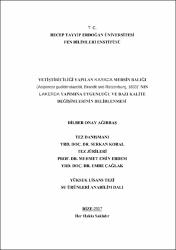Yetiştiriciliği yapılan karaca Mersin balığı (Acipencer gueldenstaedtii, Brandt and Ratzenburg, 1833)'nın lakerda yapımına uygunluğu ve kalite değişimlerinin belirlenmesi
Özet
Yapılan bu çalışmada, yetiştircilik yoluyla üretilen Karaca Mersin balığından (Acipencer gueldenstaedtii, Brandt and Ratzenburg, 1833) elde edilen lakerdanın, kendi salamurasında ve vakum paketlenerek buzdolabı koşullarında (4±1°C) 7 ay süreyle muhafazası esnasında meydana gelen kalite değişimleri (biyokimyasal, fizikokimyasal, mikrobiyolojik ve duyusal) araştırılarak hem yeni üretilen bu ürünün tüketici kabulü hemde en uygun muhafaza yönteminin tespiti amaçlanmıştır. Araştırmada kullanılan Karaca mersini (Acipenser gueldenstaedtii) Recep Tayyip Erdoğan Üniversitesi bünyesinde bulunan İyidere Araştırma ve Uygulama Merkezi'nden temin edilmiştir. Çalışmada, ortalama boyları 76,50±3,24 cm ve ortalama ağırlıkları 2425,20±347,42 g olan 10 adet Karaca Mersin balığı kullanılmıştır. %25 (a:a) oranda kaya tuzu kullanılarak üretilen lakerdanın tuz oranı %11,91 olarak bulunurken depolamanın 6. ayında bu değer vakum paket ve salamura gruplarında sırası ile %11,41 ve %12,26 olarak tespit edilmiştir. Her iki grupta da depolama süresince yapılan toplam uçucu bazik azot (TVB-N), tiobarbitürik asit (TBA) ve mikrobiyolojik analizlerden toplam mezofilik bakteri sayısı (TMBS), toplam psikrofilik bakteri sayısı (TPBS) ile ilgili tüketim sınır değerleri aşılmamıştır. Duyusal değerlendirme aşamasında, vakum paket grubu panelistler tarafından daha çok beğenilmesine rağmen her iki grupta 7. ayda tüketim limit değerinin altına düşerek bozulmuşlardır. Çalışmadan elde edilen verilere göre her iki grubun raf ömrü 6 ay olarak tespit edilmiştir.In this study, the quality changes (biochemical, physicochemical, microbiological and sensory) in lakerda obtained from cultured Russian sturgeon (Acipencer gueldenstaedtii, Brandt and Ratzenburg, 1833) were investigated and it is aimed to determine the most suitable preservation method both acceptance of the consumer of this newly produced product during the 7 months of storage at refrigerator conditions (4 ± 1°C). Russian sturgeon (Acipencer gueldenstaedtii) used in the present study was obtained from the İyidere Research and Application Center at Recep Tayyip Erdogan University. In the study, 10 Russian sturgeons, average length of 76,50 ± 3,24 cm and average weight of 2425,20 ± 347,42 g, were used. The salt ratio (%) was determined as 11,91% in lakerda which was produced by using 25% (w:w) salt concentration, however, this value was determined as 11,41% and 12,26% in the vacuum package and brine groups, respectively at 6 months of storage. In both groups, the consumption limit values for the total volatile basic nitrogen (TVB-N), thiobarbituric acid (TBA) and total mesophilic bacteria (TMBS), total number of psychrophilic bacteria (TPBS) from microbiological analyzes were not exceeded during the storage period. In the sensory evaluation period, although the vacuum package group was more appreciated by panelists, in both groups, consumption decreased below the limit value at 7 months. According to the data obtained from the sudy, the shelf life of both groups was determined as 6 months.
Bağlantı
https://hdl.handle.net/11436/757Koleksiyonlar
- Fen Bilimleri Enstitüsü [340]


















